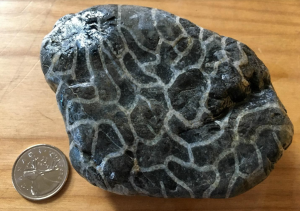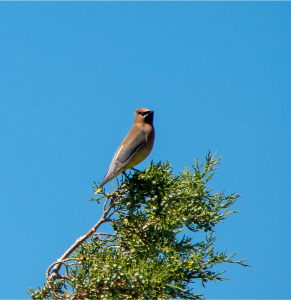AMPed UP! September 2020 Edition
Welcome to our first edition of Columbia Lake Stewardship Society’s AMPed Up! Series. These series include a short article on a local Animal, Mineral and Plant. Today’s series features a cheeky bird, a geological gem, and the scoop on aquatic vegetation.
Enjoying Berries on a Sunny Day…
This cedar waxwing was recently seen dining on ripe juniper berries near the shores of Columbia Lake. Cedar Waxwings love fruit although in the summer they eat lots of insects as well.
The cedar waxwing is one of the few North American bird that specializes in eating fruit. Because they eat so much fruit, they occasionally become intoxicated or even die
when they run across overripe berries that have started to ferment and produce alcohol.
Many Cedar Waxwings migrate, but they may also stay near Columbia Lake all year round. The Cedar Waxwing is of low concern from a conservation perspective.
For more information go to Cornell university’s All About Birds for more information.
A Chunk of Aquatic History

There are lots of rocks and pebbles along the shores of Columbia Lake. Have you ever noticed one that looks really different? This is a photo of a rock collected on the shore of the lake. It is covered in squiggly lines. Those lines are actually what remains of a lower Paleozoic coral, commonly called a chain coral. It was alive some 540 – 419 MILLION years ago. Since then, it has been on quite a trip. After the coral died and fell to the sea floor, it would have been buried with sediment. Over time, the coral was replaced by quartz. If you look closely, you can still see the walls of the coral in the quartz.
Between the time it was deposited and today, the coral has been buried deeply, subjected to intense heat and pressure, called metamorphism, lifted high up into a mountain range and eroded off as a piece scree. The scree was moved along by water, which smoothed out the edges of the scree and eventually that Paleozoic coral ended up on the shores of Columbia Lake. What a ride!
Follow this link for more information about the Geology of British Columbia.
Aquatic Vegetation: Friends or Foe?
 What would it look like if all the water were drained from Columbia Lake? There would be more than just mud and minnows left behind. In fact, what would remain would likely resemble a soaked grassland. Columbia Lake is full of aquatic plants such as northern milfoil, white-stemmed pondweed, and cattails, just to name a few.
What would it look like if all the water were drained from Columbia Lake? There would be more than just mud and minnows left behind. In fact, what would remain would likely resemble a soaked grassland. Columbia Lake is full of aquatic plants such as northern milfoil, white-stemmed pondweed, and cattails, just to name a few.
In a recent public engagement process for the Columbia Lake Management Plan, residents voiced some concern over the abundance of these plants in the lake. What role do these plants play in the lake’s ecosystem, and can there ever be too many of them? Let’s explore.
- Aquatic plants serve as a food source for organisms. Ducks and geese feed on the seeds and leaves produced by some of these plants, and invertebrates, such as freshwater insects, rely on them as their main source of food.
. - Aquatic plants also provide habitat for organisms. For example, smaller forms of aquatic life hide in patches of plants like northern milfoil in order to avoid predators.
. - Aquatic plants also play an important role in erosion control, nutrient cycling, and protection against invasive plant species.
So, can you ever have too many aquatic plants? There are some problems that can arise when these underwater forests grow too dense. These plants can be a nuisance to swimmers and boaters. Dense plant growth can also lower levels of dissolved oxygen at night, which can have a negative impact on fish. And, of course, if aquatic plants are an invasive species, then in any amount they are considered too much. Currently, however, no aquatic invasive plant species have been detected on Columbia Lake.
For more information, follow this link!







